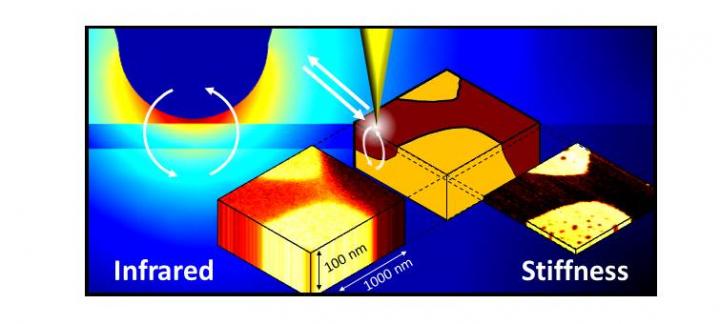CIC nanoGUNE reaches new depths in infrared nanospectroscopy

Illustration of subsurface infrared nanoimaging. Credit: CIC nanoGUNE
Optical spectroscopy with infrared light, such as Fourier transform infrared (FTIR) spectroscopy, allows for chemical identification of organic and inorganic materials.
The smallest objects which can be distinguished with conventional FTIR microscopes have sizes on the micrometre-scale. Scientists at CIC nanoGUNE (San Sebastian), however, employed nano-FTIR to resolve objects, which can be as small as a few nanometres.
In nano-FTIR (which is based on near-field optical microscopy), infrared light is scattered at a sharp metallized tip of a scanning-probe microscope.
The tip is scanned across the surface of a sample of interest and the spectra of scattered light are recorded using Fourier transform detection principles.
Recording of the tip-scattered light yields the sample's infrared spectral properties and thus the chemical composition of an area located directly below the tip apex.
Because the tip is scanned across the sample surface, nano-FTIR is typically considered to be a surface-characterization technique.
Importantly though, the infrared light that is nano-focussed by the tip does not only probe a nanometric area below the tip, but in fact probes a nanometric volume below the tip.
Now the researchers at CIC nanoGUNE showed that spectral signatures of materials located below the sample surface can be detected and chemically identified up to a depth of 100 nm.
Furthermore, the researchers showed that nano-FTIR signals from thin surface layers differ from that of subsurface layers of the same material, which can be exploited for determination of the materials distribution within the sample.
Remarkably, surface layers and subsurface layers can be distinguished directly from experimental data without involving time-consuming modelling. The findings have recently been published in Nature Communications.
Media Contact
Irati Kortabitarte
i.kortabitarte@elhuyar.eus
Media Contact
All latest news from the category: Physics and Astronomy
This area deals with the fundamental laws and building blocks of nature and how they interact, the properties and the behavior of matter, and research into space and time and their structures.
innovations-report provides in-depth reports and articles on subjects such as astrophysics, laser technologies, nuclear, quantum, particle and solid-state physics, nanotechnologies, planetary research and findings (Mars, Venus) and developments related to the Hubble Telescope.
Newest articles

Properties of new materials for microchips
… can now be measured well. Reseachers of Delft University of Technology demonstrated measuring performance properties of ultrathin silicon membranes. Making ever smaller and more powerful chips requires new ultrathin…

Floating solar’s potential
… to support sustainable development by addressing climate, water, and energy goals holistically. A new study published this week in Nature Energy raises the potential for floating solar photovoltaics (FPV)…

Skyrmions move at record speeds
… a step towards the computing of the future. An international research team led by scientists from the CNRS1 has discovered that the magnetic nanobubbles2 known as skyrmions can be…





















